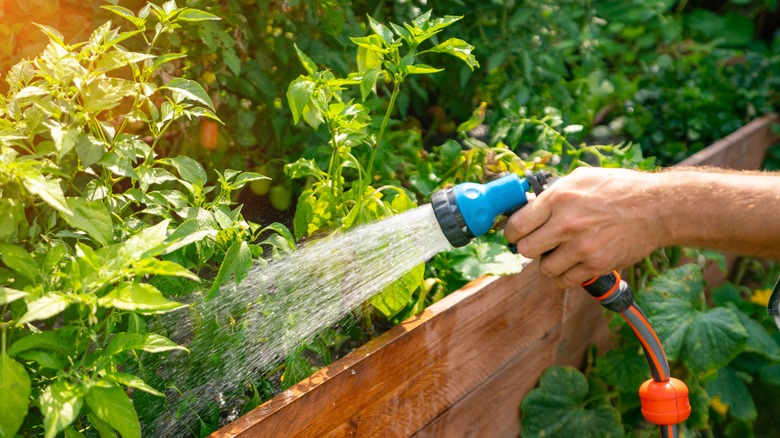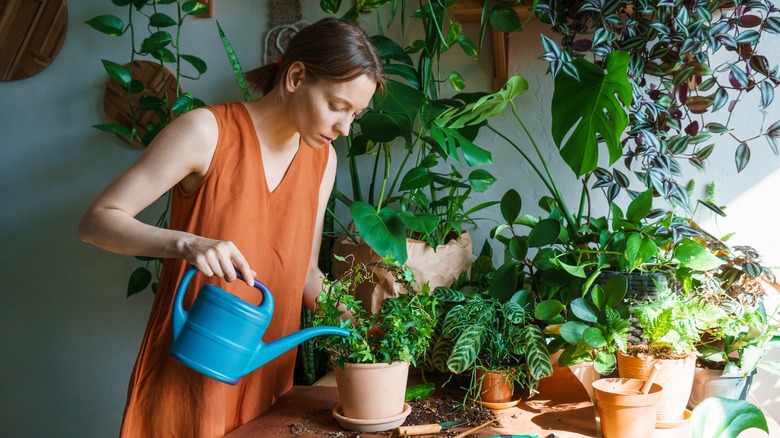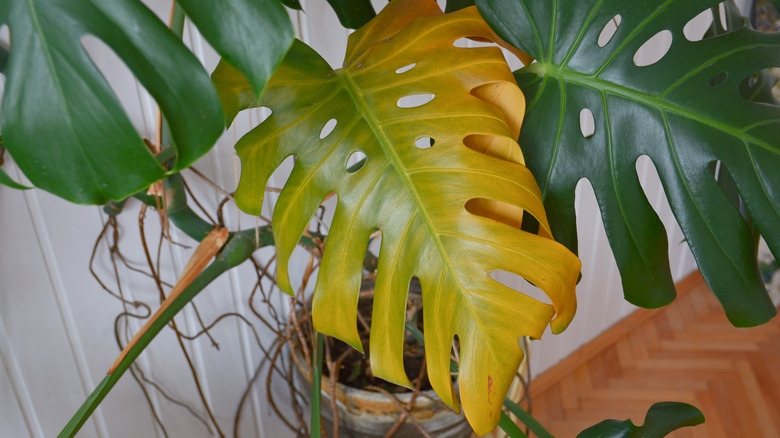This Is The Best Time Of Day To Water Your Plants
Maintaining plants can become a full-time job as they require extensive care. Whether you have a garden full of daisies or a few rose bushes, one of the common needs of your cultivars is water. As West Virginia University Extension points out, water is the main ingredient plants require to live as it makes up around 95% of their tissue. In addition, it's responsible for several important functions, including carrying other nutrients it needs to survive. So while it's clear greenery can't survive without water, the time they get watered is also crucial.
While many take the approach of watering flowers and shrubs whenever they see fit, this could be dangerous. When this happens, your plants are at risk of being overwatered or not getting enough to drink. According to Livspace, improper watering is the main reason greenery doesn't survive. Of course, each plant has its own watering needs; however, a certain time of the day works best for many species.
Water your plants in the morning
The best time you can water your plants is in the morning, says PureWow. While this routine should be done throughout the year, it's almost crucial in the summertime. This lets the plants absorb the water before it gets too hot and the sun evaporates it. This specific time also allows for foliage to dry quickly and prevents bacteria, such as fungi, from spreading. Livingetc furthers this by stating that it also helps keep pests at a distance.
However, not everyone is able to water their shrubs at the break of dawn. Therefore, there are a few other times of the day you can water them as well: Food52 says that watering your plants in the late afternoon or early evening works almost just as well. It still allows time for the water to soak into the soil before nightfall.
Still, it's imperative to know that giving your greenery to drink when it is dark out is not a good idea as it allows the water to just sit on top of the soil and leaves instead of getting soaked in. In return, it can cause bacteria to accumulate as well as attract pesky bugs. On the other hand, the sun plays an important part in the watering process; therefore, it should be okay to give the plants to drink whenever the sun is out if you didn't get the chance to do it in the first hours of the day.
Signs plants need more or less water
Sometimes, plants need to be watered a bit more or a bit less. This can be the cause of many factors, such as environment or plant type. Luckily, your cultivar will show signs when it's in distress. According to PureWow, one of the easiest ways to see if your plant is dry is by sticking your finger into the soil. If it feels dry, you need to give it to drink. You can also take a look at the plants' leaves. If they're drooping, look brown, or have a wrinkly texture, they need more water. Lastly, pick your plant up and feel how heavy it is (if you keep it in a pot). If it is too light, you may need to give it a drink.
Similarly, if your plants are retaining too much water, there will be a few signs to watch out for. Per Bloomscape, if the leaves are wilting and the soil is wet, the root can't retain any more water. No matter the color, if your plant's leaves are falling off, alive or dead, this is another sign you should cut on the water. Finally, if you notice any bacteria, such as mold or fungi, your cultivar has stored too much water in the soil. More often than not, you'll see insects and bugs around this area as well, so ensure you're not giving the plant to drink until the soil is dry and its leaves catch life again.


